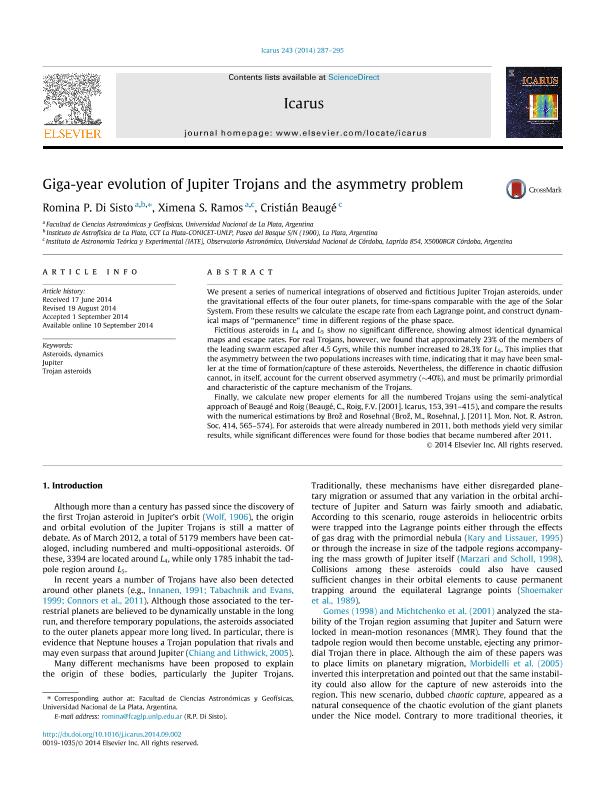Mostrar el registro sencillo del ítem
dc.contributor.author
Di Sisto, Romina Paula

dc.contributor.author
Ramos, Ximena Soledad

dc.contributor.author
Beauge, Cristian

dc.date.available
2018-01-03T22:09:01Z
dc.date.issued
2014-09
dc.identifier.citation
Beauge, Cristian; Ramos, Ximena Soledad; Di Sisto, Romina Paula; Giga-year evolution of Jupiter Trojans and the asymmetry problem; Elsevier Inc; Icarus; 243; 9-2014; 287-295
dc.identifier.issn
0019-1035
dc.identifier.uri
http://hdl.handle.net/11336/32254
dc.description.abstract
We present a series of numerical integrations of observed and fictitious Jupiter Trojan asteroids, under the gravitational effects of the four outer planets, for time-spans comparable with the age of the Solar System. From these results we calculate the escape rate from each Lagrange point, and construct dynamical maps of ‘‘permanence’’ time in different regions of the phase space. Fictitious asteroids in L4 and L5 show no significant difference, showing almost identical dynamical maps and escape rates. For real Trojans, however, we found that approximately 23% of the members of the leading swarm escaped after 4.5 Gyrs, while this number increased to 28.3% for L5. This implies that the asymmetry between the two populations increases with time, indicating that it may have been smaller at the time of formation/capture of these asteroids. Nevertheless, the difference in chaotic diffusion cannot, in itself, account for the current observed asymmetry (40%), and must be primarily primordial and characteristic of the capture mechanism of the Trojans. Finally, we calculate new proper elements for all the numbered Trojans using the semi-analytical approach of Beaugé and Roig (Beaugé, C., Roig, F.V. [2001]. Icarus, 153, 391–415), and compare the results with the numerical estimations by Brozˇ and Rosehnal (Brozˇ, M., Rosehnal, J. [2011]. Mon. Not. R. Astron. Soc. 414, 565–574). For asteroids that were already numbered in 2011, both methods yield very similar results, while significant differences were found for those bodies that became numbered after 2011.
dc.format
application/pdf
dc.language.iso
eng
dc.publisher
Elsevier Inc

dc.rights
info:eu-repo/semantics/openAccess
dc.rights.uri
https://creativecommons.org/licenses/by-nc-nd/2.5/ar/
dc.subject
Asteroids
dc.subject
Dynamics
dc.subject
Jupiter
dc.subject
Trojan Asteroids
dc.subject.classification
Astronomía

dc.subject.classification
Ciencias Físicas

dc.subject.classification
CIENCIAS NATURALES Y EXACTAS

dc.title
Giga-year evolution of Jupiter Trojans and the asymmetry problem
dc.type
info:eu-repo/semantics/article
dc.type
info:ar-repo/semantics/artículo
dc.type
info:eu-repo/semantics/publishedVersion
dc.date.updated
2018-01-03T20:12:02Z
dc.journal.volume
243
dc.journal.pagination
287-295
dc.journal.pais
Estados Unidos

dc.description.fil
Fil: Di Sisto, Romina Paula. Universidad Nacional de la Plata. Facultad de Ciencias Astronómicas y Geofísicas; Argentina. Consejo Nacional de Investigaciones Científicas y Técnicas. Centro Científico Tecnológico Conicet - La Plata. Instituto de Astrofísica La Plata. Universidad Nacional de La Plata. Facultad de Ciencias Astronómicas y Geofísicas. Instituto de Astrofísica la Plata; Argentina
dc.description.fil
Fil: Ramos, Ximena Soledad. Universidad Nacional de la Plata. Facultad de Ciencias Astronómicas y Geofísicas; Argentina. Consejo Nacional de Investigaciones Científicas y Técnicas. Centro Científico Tecnológico Conicet - Córdoba. Instituto de Astronomia Teórica y Experimental. Universidad Nacional de Córdoba. Observatorio Astronómico de Córdoba. Instituto de Astronomia Teórica y Experimental; Argentina
dc.description.fil
Fil: Beauge, Cristian. Consejo Nacional de Investigaciones Científicas y Técnicas. Centro Científico Tecnológico Conicet - Córdoba. Instituto de Astronomia Teórica y Experimental. Universidad Nacional de Córdoba. Observatorio Astronómico de Córdoba. Instituto de Astronomia Teórica y Experimental; Argentina
dc.journal.title
Icarus

dc.relation.alternativeid
info:eu-repo/semantics/altIdentifier/doi/http://dx.doi.org/10.1016/j.icarus.2014.09.002
dc.relation.alternativeid
info:eu-repo/semantics/altIdentifier/url/http://www.sciencedirect.com/science/article/pii/S0019103514004643
Archivos asociados
